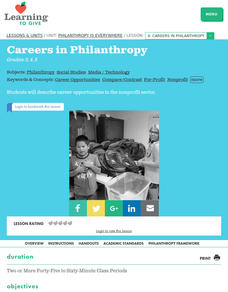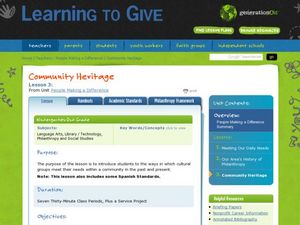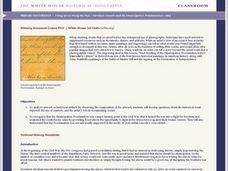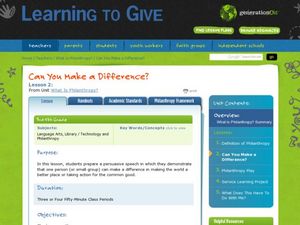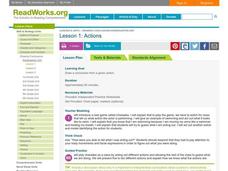Curated OER
Philanthropy is Everywhere Lesson 4: Careers in Philanthropy
Students discover career opportunities in the non-profit sector. They look at local business to determine compare and contrast for profit and non-profit businesses. They participate in a non-profit job fair.
Curated OER
Identify the Three Economic Sectors
Students identify the three economic sectors found in the United States. They organize different foundations into these three categories. They examine why each sector is necessary in our society.
Curated OER
Making Good Money Choices
Students play a game called Philanthropy EconAround Bingo and learn how to make smart money choices. In this money choices lesson plan, students play the game and discuss what choices would be better than others to maximize their money.
Curated OER
Who Will Benefit if We Give Bulbs What They Need to Grow?
Students identify the elements needed for bulbs to grow. They raise tulips and give them to various members of the community. They identify local philanthropic communities and look for ways they can constructively donate time and give...
Curated OER
Community Heritage
Students discuss cultural issues in their community. In this cultural lesson plan, students meet a local Hispanic activist and discuss current issues in the community.
Curated OER
Lesson One: Characterizing Philanthropic People
Familiarize your class with philanthropy and involve individuals in philanthropic activities. First, determine the traits of philanthropic people. Class members attach sticky notes with character traits written on them to each side of at...
Curated OER
Our Land
Students recognize the difference between public and private property. In this public and private lands lesson, students discuss the places mentioned in the song "This Land is Your Land." Students create a T-chart showing public and...
Curated OER
We Are the Government
Students read primary documents to find the motivations of the founding fathers of the United States. In this primary documents lesson, students discuss the meaning of the Preamble to the Constitution, read parts of the Constitution...
Curated OER
A Read-In
Students explore philosophy by participating in a philanthropic activity. In this book read-in lesson plan, students collect a group of used books and illustrate an image to go along with the story. Students donate these books to a...
Curated OER
Stitching Truth Lesson One: What is Civil Society?
Ninth graders create a working definition of civil society. In this US History instructional activity, 9th graders create a list of terms that help make up the term civil society. Students examine the case study of life in Pinochet's...
Curated OER
Maya Lin
Students are able to explain the important contribution Maya Lin made to society, write about their definition of a hero, and recognize, appreciate and describe the significance of memorials.
Curated OER
Using Art to Study the Past: Abraham Lincoln and the Emancipation Proclamation - 1863
Fifth graders analyze artwork as historical artifact and recognize that the Emancipation Proclamation was a major turning point in the Civil War.
Curated OER
Social Entrepreneurship
Students define the term "social entrepreneurs" and research several examples of this concept in action. They, in groups, research and discuss several questions.
Curated OER
Can You Make a Difference?
Students write and present a speech. In this service lesson, students read an anecdote adapted from The Star Thrower and discuss their feelings about their ability to make a difference in the world. Students make a short speech about...
Curated OER
We Need More Than Money
Students identify examples of private resources. In this philanthropy lesson, students read the book A Chair for My Mother and identify the private resources the characters used in the text. Students name private resources that can help...
Curated OER
These Lakes are Great
Young scholars examine the Great Lakes Basin and water conservation. In this Great Lakes and water lesson plan, students study the location of the lakes before reading the book, The River Ran Wild. They discuss the associated vocabulary...
Curated OER
Stay in the Mix ...With Summer Service!
Students explore the concept of philanthropy. In this service learning lesson, students consider community service work they may complete when school is not in session.
Curated OER
Physical Attributes
Practice describing the physical attributes of story characters. After listening to a story, kindergartners identify each of the characters. They then draw a picture of the characters from the book.
Curated OER
Main and Secondary Characters
Identify main and secondary characters from a fiction story. Kindergartners do a picture walk with the teacher, and then do the identifying on their own with another book. A good assignment for groups or a whole class to complete.
Curated OER
Identifying What is Different
What is the same, what is different, and what does it all mean? Introduce the concept of identifying similarities and difference to your Kinder class using the I do, we do, you do, instructional approach. You'll provide structured...
Curated OER
Actions
Students pair up and one of the students acts out an action while the other draws conclusions from their actions by drawing a picture of what they are doing. In this actions lesson plan, students play charades and guess what each other...
Curated OER
Opinion
An important concept for youngsters to learn is that there is a difference between facts and opinions. Use Kirsten Hall's Animal Touch to introduce the idea that an opinion is how one feels or thinks about something and that others are...
Curated OER
Identifying Facts and Forming Opinions
Kirsten Hall's animal books provide learners with an opportunity to practice forming statements of opinions and factual statements. Using sentence starters such as "I learned. . ." and "I think. . ." class members craft sentences cite a...
Curated OER
Tells a Story
Students discover the concept of a biography. In this biography lesson, students read, A Picture Book of Amelia Earhart by David A. Adler. They see how biographies tell a story and then work together to identify the beginning, middle,...


